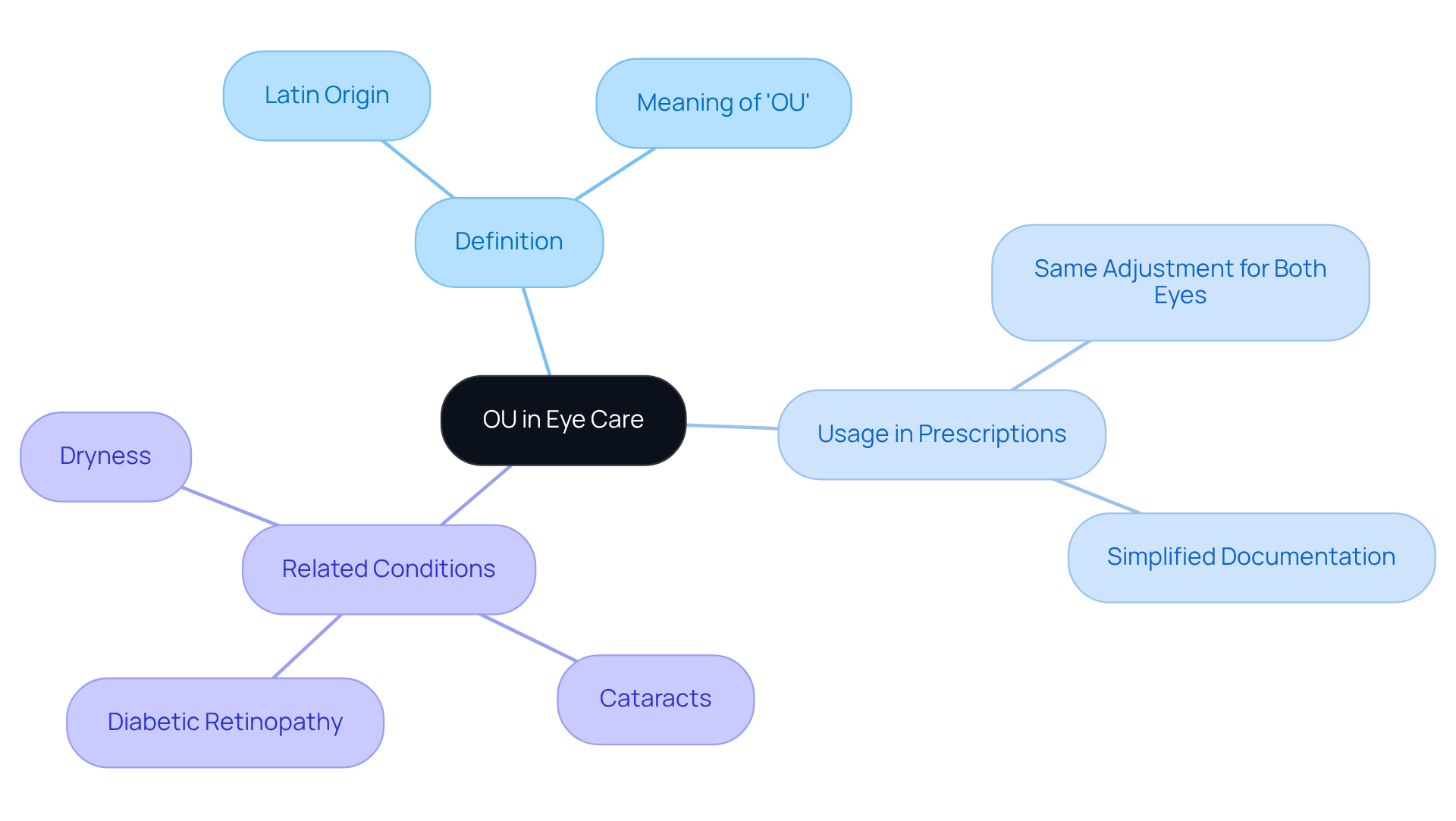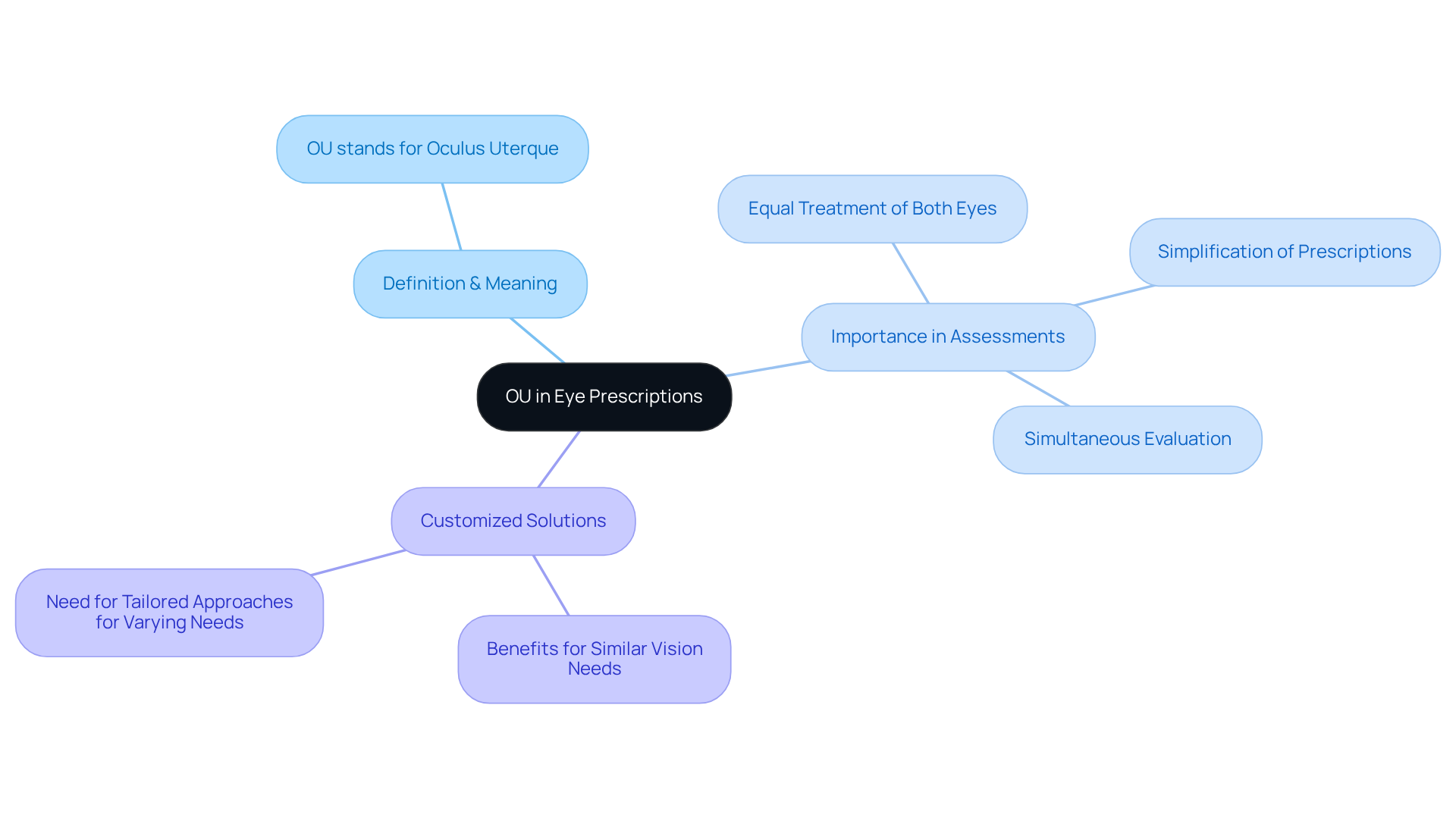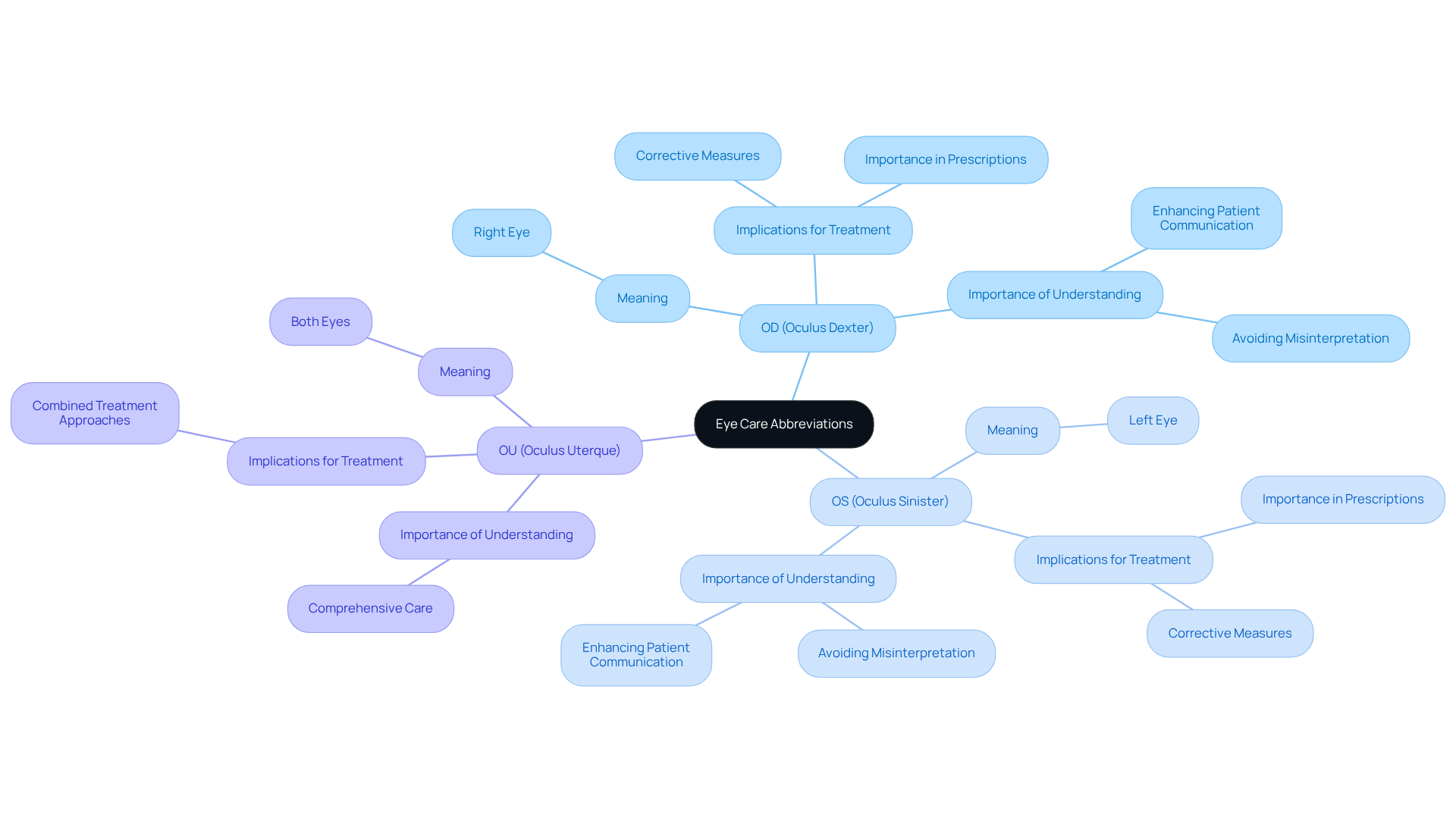Posted by: Northwest Eye in General on October 3, 2025
Overview
The term “OU,” which stands for ‘Oculus Uterque’ meaning ‘both eyes,’ is significant in eye care. It indicates that the same prescription applies to both eyes, which facilitates clearer communication and efficient treatment. We understand that navigating eye care can be overwhelming, and knowing these terms can help ease your concerns.
Understanding this term, along with related abbreviations like ‘OD’ for the right eye and ‘OS’ for the left, empowers you to engage effectively with your eye care professionals. This ensures you receive the appropriate and personalized vision correction you deserve. Remember, we are here to help you through this process, and your comfort is our priority.
Introduction
Understanding the nuances of eye care terminology can significantly enhance your experience when navigating vision health. The term “OU,” derived from the Latin “Oculus Uterque,” signifies that both eyes are being treated equally. This is a crucial aspect to consider when interpreting prescriptions and engaging with eye care professionals. We understand that many patients may remain unaware of its implications, which can lead to confusion during consultations and treatment plans.
What does this abbreviation truly mean for your eye care? Grasping its significance can empower you to take charge of your ocular health.
Define OU: Understanding the Term in Eye Care
OU stands for ‘Oculus Uterque,’ a Latin term that means ‘both orbs.’ In the context of vision treatment, this term is often used in prescriptions to convey the ou eye meaning that the same adjustment applies to both eyes. This designation is crucial for eye health professionals when documenting visual acuity and recommending corrective lenses. For instance, if someone requires the same prescription for both eyes, the documentation process will be simplified by using the notation ‘OU’, which has the ‘ou eye meaning’.
We understand that navigating your eye health can be overwhelming, and grasping this term can help you better interpret your prescriptions. It also enables you to engage in informed discussions with your eye specialists. Factors leading to blurred vision, such as:
- cataracts
- diabetic retinopathy
- dryness
can affect both eyes. Recognizing the ou eye meaning in relation to these conditions allows you to communicate your symptoms and treatment options more effectively with your eye care professionals. Remember, we are here to help you through this process.

Significance of OU in Eye Prescriptions and Examinations
The designation ‘OU,’ which signifies ‘Oculus Uterque’—the ou eye meaning of both orbs—plays a crucial role in visual assessments. It indicates that both orbs are treated equally, which is especially important for individuals with similar vision requirements. For instance, if someone has a -2.00 notation for both orbs, it would be recorded as ‘OU -2.00.’ This simplification streamlines the medication process and ensures balanced vision correction, enhancing overall visual comfort.
We understand that during vision examinations, ‘OU’ allows for the simultaneous evaluation of visual sharpness in both orbs, providing a comprehensive overview of an individual’s ocular health. This approach is particularly beneficial for those needing identical corrections, as it ensures their lenses are crafted to meet their specific vision needs effectively. Dr. Steven Liem emphasizes, ‘When you see the ou eye meaning on your document, it means that the vision correction values apply to both your right and left eyes equally.’
By utilizing ‘OU,’ eye specialists can deliver customized solutions that enhance outcomes for individuals, fostering a more efficient and effective treatment experience. However, it’s important to note that while ‘OU’ is advantageous for individuals with similar vision requirements, patients with varying needs for each eye may require a more tailored approach. We are here to help you through this process and ensure you receive the care you deserve.

Contextualizing OU: Comparison with OD and OS
In the field of eye care, we understand that navigating medical terminology can be overwhelming. The abbreviations ‘OD’ and ‘OS’ are essential for interpreting orders, and knowing what they mean can ease your concerns. ‘OD’ stands for ‘Oculus Dexter,’ which denotes the right eye, while ‘OS’ signifies ‘Oculus Sinister,’ referring to the left eye. Mastery of these terms is crucial for accurately understanding your eye care needs.
For instance, a prescription may state ‘OD -2.00, OS -2.50, OU -2.00.’ This indicates that your right eye requires a -2.00 correction, your left eye a -2.50 correction, and both eyes together a -2.00 correction. Recognizing these distinctions allows eye specialists to tailor treatments to the unique needs of each eye, ensuring that your overall vision requirements are met.
It’s common to feel anxious about misinterpretations in eye care. Statistics indicate that misunderstandings of OD and OS can lead to significant treatment errors, highlighting the necessity of clear communication. As optometrists emphasize, “Grasping these abbreviations cultivates trust and accuracy in service delivery, ultimately improving patient satisfaction.”
By understanding the differences between OD, OS, and OU, where the OU eye meaning is ‘Oculus Uterque,’ indicating both eyes, you can engage more effectively in your eye care discussions. This knowledge empowers you to ask questions and seek clarity, leading to improved outcomes and personalized treatment plans. We are here to help you through this process, ensuring that your eye care experience is as smooth and reassuring as possible.

Conclusion
Understanding the term ‘OU,’ which stands for ‘Oculus Uterque,’ is essential for anyone navigating the complexities of eye care. We recognize that this designation signifies that both eyes are treated equally, providing clarity in prescriptions and ensuring effective communication with eye care professionals. By familiarizing yourself with the OU eye meaning, you can engage more confidently in discussions about your visual health and treatment options.
Throughout this article, we have emphasized the importance of ‘OU’ in eye prescriptions and examinations. It streamlines the process for individuals requiring similar corrections in both eyes, simplifying documentation and enhancing overall visual comfort. It’s common to feel overwhelmed, but understanding ‘OU’ alongside comparisons with ‘OD’ and ‘OS’ highlights the necessity of these terms to avoid potential treatment errors. Knowledge of these abbreviations fosters better communication between you and your eye care specialists, ultimately leading to more personalized treatment approaches.
In conclusion, grasping the significance of ‘OU’ in eye care not only empowers you to take charge of your vision health but also promotes a more effective and reassuring eye care experience. As you become more informed about the terminology and its implications, you can advocate for yourself and ensure that you receive the tailored care you deserve. Engaging with eye care professionals using this knowledge can lead to improved outcomes and a deeper understanding of your visual health journey.
Frequently Asked Questions
What does the term “OU” mean in eye care?
“OU” stands for “Oculus Uterque,” a Latin term that means “both orbs.” It is used in prescriptions to indicate that the same adjustment applies to both eyes.
Why is the “OU” designation important for eye health professionals?
The “OU” designation is crucial for documenting visual acuity and recommending corrective lenses. It simplifies the documentation process when a patient requires the same prescription for both eyes.
How can understanding the term “OU” help patients?
Understanding the term “OU” can help patients better interpret their prescriptions and engage in informed discussions with their eye specialists.
What conditions can lead to blurred vision in both eyes?
Conditions such as cataracts, diabetic retinopathy, and dryness can affect both eyes and lead to blurred vision.
How does recognizing the “OU” meaning assist in communication with eye care professionals?
Recognizing the “OU” meaning allows patients to communicate their symptoms and treatment options more effectively with their eye care professionals.






